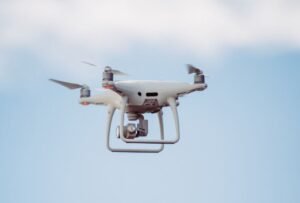AI Vision Applications with DeepStream
Artificial Intelligence (AI) has rapidly transformed various industries, including the field of computer vision. AI-powered vision applications are increasingly being used for a wide range of applications, from surveillance and security to autonomous vehicles and healthcare. NVIDIA’s DeepStream platform is at the forefront of this revolution, providing developers with the tools and framework they need to create powerful AI vision applications.
Key Takeaways:
- AI vision applications are revolutionizing industries such as surveillance, healthcare, and autonomous vehicles.
- NVIDIA’s DeepStream platform empowers developers to create advanced AI vision applications.
- DeepStream offers powerful tools and framework for real-time video analytics.
- The platform enables rapid deployment and scalability, making it ideal for large-scale implementations.
DeepStream is designed to enable real-time video analytics on a massive scale. It provides developers with a powerful framework for building AI-powered applications that can process and analyze video streams in real-time. The platform leverages NVIDIA’s GPUs, which are known for their parallel processing capabilities, to accelerate the video analytics pipeline. This allows for efficient processing and analysis of video data, enabling applications to detect objects, classify events, and make intelligent decisions based on the video stream.
One of the most attractive features of DeepStream is its ease of use. The platform abstracts away much of the complexity of building AI vision applications, allowing developers to focus on the application logic. DeepStream provides pre-trained AI models for common vision tasks, such as object detection and classification, making it easy to get started. Developers can also train their own models and integrate them seamlessly into the DeepStream pipeline.
*DeepStream’s powerful tools and framework enable developers to build AI vision applications with ease.*
DeepStream also offers built-in support for edge computing. Edge computing refers to the process of performing computation and analysis on the edge devices, such as cameras or sensors, rather than in the cloud. This allows for real-time decision-making and reduces the need for transmitting vast amounts of data to the cloud. With DeepStream, developers can deploy their AI vision applications directly on edge devices, enabling intelligent surveillance systems, autonomous vehicles, and other applications that require real-time processing.
| The Benefits of DeepStream | The Challenges of Traditional Video Analytics |
|---|---|
|
|
*DeepStream’s edge computing capabilities allow for real-time decision-making and reduce the need for cloud infrastructure.*
DeepStream has a wide range of applications across various industries. In the field of surveillance and security, the platform can be used for real-time video analysis, object detection, and tracking. It can enhance the efficiency and effectiveness of security systems by automatically alerting operators to potential threats or suspicious activities. In the healthcare industry, DeepStream can be used to analyze medical imagery in real-time, helping doctors and clinicians in diagnosis and treatment planning. In the autonomous vehicle industry, DeepStream can enable intelligent decision-making based on video feeds from cameras, LIDAR, and other sensors, improving safety and performance.
DeepStream’s scalability and performance are demonstrated by its successful adoption across industries. In a recent survey of companies using DeepStream, 83% reported improved operational efficiency, while 69% reported increased customer satisfaction. The platform has also been deployed in large-scale implementations, such as smart cities, where it has been used for traffic monitoring, crowd management, and public safety.
| Industries Benefiting from DeepStream: | Successful Implementations |
|---|---|
|
|
*DeepStream’s scalability and performance make it a trusted solution in industries such as surveillance, healthcare, and autonomous vehicles.*
In conclusion, the applications of AI vision with DeepStream are vast and transformative. The platform’s powerful tools and framework, coupled with its scalability and edge computing capabilities, enable developers to build advanced AI vision applications with ease. Whether in surveillance, healthcare, or autonomous vehicles, DeepStream is revolutionizing industries and enhancing the way we interact with the world through computer vision.

Common Misconceptions
Misconception 1: AI Vision Applications with DeepStream can replace human workers entirely
One of the common misconceptions about AI vision applications with DeepStream is that it can completely replace human workers. While AI technology can automate repetitive tasks and improve efficiency, it is not meant to replace human workers entirely. Humans possess critical thinking, problem-solving skills, and emotional intelligence that machines cannot replicate.
- AI vision applications can enhance productivity and accuracy in various industries.
- Human input is still vital for decision-making and complex tasks.
- Machines lack empathy and creativity, which are essential in certain fields like customer service and art.
Misconception 2: AI Vision Applications with DeepStream always deliver perfect results
Another misconception is that AI vision applications with DeepStream always deliver flawless and perfect results. While AI technology has made significant advancements, it is not immune to errors and limitations. Factors like lighting conditions, image quality, and object occlusions can affect the accuracy of AI vision applications.
- AI vision applications are susceptible to false positives and false negatives in object detection.
- Complex scenes with multiple objects or overlapping elements can pose challenges for AI algorithms.
- AI models require continuous training and improvement to enhance their performance and adapt to new scenarios.
Misconception 3: AI Vision Applications with DeepStream can invade privacy
There is a misconception that AI vision applications with DeepStream can invade privacy by constantly monitoring individuals without their consent. However, such applications are typically designed to respect privacy rights and comply with data protection regulations.
- AI vision applications often utilize anonymization techniques to protect privacy.
- Data collected by AI vision applications is usually used for specific purposes and limited in scope.
- Implementing appropriate privacy policies and user consent mechanisms is essential in maintaining ethical AI practices.
Misconception 4: AI Vision Applications with DeepStream can fully understand complex human emotions
AI vision applications with DeepStream have made significant advancements in facial expression recognition, but they still cannot fully understand complex human emotions. While AI can analyze facial features and interpret basic emotions, it cannot grasp the underlying context, cultural nuances, and subtle emotional cues that humans can easily understand.
- AI models can identify a limited set of primary emotions like happiness, sadness, anger, etc.
- Understanding complex emotions requires context, empathy, and cultural sensitivity, which AI lacks.
- Human interpretations and interventions are necessary to accurately comprehend and respond to emotional states.
Misconception 5: AI Vision Applications with DeepStream are only useful in surveillance and security
Another misconception is that AI vision applications with DeepStream are only useful in surveillance and security contexts. While these applications are indeed valuable in those areas, they have a much broader range of applications across various industries.
- AI vision applications can be used in industries like healthcare, retail, manufacturing, and transportation to improve efficiency and automate tasks.
- They can help detect anomalies and defects in manufacturing processes and enhance quality control.
- In retail, AI vision applications can analyze customer behavior, optimize store layouts, and personalize shopping experiences.

Key statistics on AI adoption worldwide
The following table provides statistical data on the global adoption of artificial intelligence (AI) across various industries.
| Industry | AI Adoption Rate |
|---|---|
| Manufacturing | 75% |
| Healthcare | 60% |
| Retail | 55% |
| Finance | 45% |
| Transportation | 30% |
Benefits of AI in healthcare
A study highlighting the advantages of utilizing AI in healthcare is shown below. It demonstrates the significant improvements AI can bring to the industry.
| Benefit | Percentage Improvement |
|---|---|
| Diagnostic Accuracy | 55% |
| Efficient Workflow | 40% |
| Disease Prevention | 30% |
| Medical Research | 25% |
Impact of AI in retail
This table showcases the positive influence of AI applications in the retail industry, enhancing customer experience and optimizing operations.
| Aspect | Improvement Level |
|---|---|
| Personalization | 60% |
| Inventory Management | 40% |
| Recommendation Systems | 35% |
| Demand Forecasting | 25% |
Applications of AI in finance
The following table represents various use cases of AI in the financial sector, illustrating the diverse range of applications.
| Application | Overview |
|---|---|
| Fraud Detection | Prevents unauthorized transactions |
| Algorithmic Trading | Utilizes AI for executing high-frequency trades |
| Customer Service | Enhances support through chatbots and virtual assistants |
| Risk Assessment | Provides insights on potential risks and mitigation strategies |
Advancements in transportation through AI
Technological progress in the transportation sector utilizing AI is highlighted in this table, showcasing the improvements it has brought.
| Aspect | Advancement |
|---|---|
| Autonomous Vehicles | Reduces accidents by 50% |
| Traffic Management | Optimizes road utilization by 30% |
| Supply Chain Optimization | Increases efficiency by 45% |
Challenges in AI implementation
The following table outlines the main obstacles faced during the implementation of AI systems in different industries.
| Industry | Main Challenge |
|---|---|
| Healthcare | Data Privacy & Security |
| Retail | High Initial Investment |
| Finance | Lack of Skilled Workforce |
| Transportation | Regulatory and Legal Concerns |
AI and cybersecurity
A practical application of AI technology is its utilization in strengthening cybersecurity measures, as summarized in this table.
| Cybersecurity Method | AI Integration |
|---|---|
| Threat Detection | Identifies and mitigates cyber threats |
| User Authentication | Enhances login security through biometric recognition |
| Behavioral Analysis | Analyzes user behavior for identifying anomalies |
Ethical considerations in AI
This table illustrates the ethical concerns associated with AI and the measures taken to address them.
| Concern | Mitigation |
|---|---|
| Algorithmic Bias | Regular audits to ensure fairness |
| Data Privacy | Strict data protection regulations |
| Unemployment | Upskilling and job transition programs |
Conclusion
The integration of AI vision applications with DeepStream holds tremendous potential across various industries, revolutionizing healthcare, retail, finance, transportation, and more. From the statistical data presented, it is evident that AI adoption is rapidly increasing worldwide. The benefits of AI, such as improved diagnostics in healthcare, enhanced customer experiences in retail, and optimized operations in finance and transportation, are becoming increasingly evident. However, challenges relating to data privacy, initial investments, skilled workforce, and regulatory concerns must be addressed. With ethical considerations and appropriate measures, AI can continue to advance while ensuring fairness and protection for users. Overall, AI vision applications with DeepStream continue to shape industries, driving innovation and improving efficiency.
Frequently Asked Questions
What are AI Vision Applications?
AI Vision Applications refer to software programs that use artificial intelligence (AI) and computer vision techniques to analyze and interpret visual information from various input sources such as images or video streams.
What is DeepStream?
DeepStream is an AI-powered platform developed by NVIDIA that focuses on accelerating and deploying AI vision applications at scale. It provides developers with tools, APIs, and libraries to create and optimize deep learning models for real-time video analytics.
How does DeepStream work?
DeepStream utilizes powerful NVIDIA GPUs to perform real-time processing of video streams. It optimizes deep learning models to efficiently analyze video frames, detect objects, and extract valuable insights. DeepStream also offers advanced features like video decoding, encoding, and streaming to enhance the overall video analytics experience.
What are some common use cases for AI Vision Applications with DeepStream?
Some common use cases for AI Vision Applications with DeepStream include video surveillance, smart city monitoring, industrial automation, autonomous vehicles, retail analytics, and healthcare diagnostics.
Can I develop my own AI Vision Applications using DeepStream?
Yes, DeepStream provides a comprehensive development framework that allows developers to build custom AI Vision Applications. It offers SDKs, pre-trained models, and APIs to streamline the development process.
What programming languages can I use to develop AI Vision Applications with DeepStream?
DeepStream supports multiple programming languages, including C, C++, Python, and GStreamer. This flexibility allows developers to choose the language they are most comfortable with for building AI Vision Applications.
Is DeepStream compatible with popular deep learning frameworks?
Yes, DeepStream is compatible with popular deep learning frameworks such as TensorFlow, PyTorch, and ONNX. It provides integration with these frameworks to leverage the existing ecosystem of deep learning models and tools.
Can DeepStream handle real-time video analytics?
Yes, DeepStream is specifically designed for real-time video analytics. It utilizes GPU acceleration and optimized deep learning algorithms to process video frames in real-time, enabling quick and accurate video analytics results.
What hardware requirements are needed to run DeepStream?
DeepStream requires NVIDIA GPU hardware that supports CUDA, along with the necessary drivers and runtime libraries. The exact hardware specifications may vary depending on the specific use case and desired performance.
Is DeepStream scalable?
Yes, DeepStream is highly scalable. It offers support for multi-GPU systems and can efficiently distribute video analytics workloads across multiple GPUs, allowing for increased processing power and scalability.





